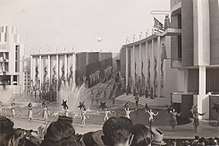Billy Rose's Aquacade
Billy Rose's Aquacade was a music, dance and swimming show produced by Billy Rose at the Great Lakes Exposition in 1937.

Later Aquacade moved to the 1939 New York World's Fair where it was the most successful production of the fair (Lowe). The Art Deco 11,000 seat amphitheatre at the north end of Meadow Lake was designed by architects Sloan & Robertson. Shows were staged by John Murray Anderson to the orchestrations of Ted Royal. The pool and the 300 by 200-foot (61 m) stage could be hidden behind a lighted 40-foot (12 m) high curtain of water.
The inaugural Aquacade starred Olympians Eleanor Holm and Johnny Weissmuller (later replaced by Buster Crabbe). Rose married Holm after divorcing his first wife, comedian Fanny Brice.
Duke Ellington played in a 1955 edition for several weeks.
For the New York Aquacade, Rose interviewed 5,000 applicants and chose 500 dancers, actors and swimmers. Gertrude Ederle, a Flushing, Queens resident and the first woman to swim the English Channel, was an Aquacade star. Queens Borough President Donald R. Manes dedicated the pool to her in 1978.
In 1940, Aquacade also opened in San Francisco at the Golden Gate International Exposition where newcomer Esther Williams replaced Holm.
The New York State Marine Amphitheatre was torn down in 1996 because of local opposition to renovating the asbestos-contaminated structure as a concert venue.
Music used for the Aquacade is held by the Music Division of The New York Public Library for the Performing Arts.
Cultural references
Literature
- Susie Orman Schnall's novel We Came Here to Shine (St. Martin's Press Griffin 2020) is historical fiction set at the 1939 New York World's Fair. The novel features two main characters: Vivi works as Aquabelle Number One in Billy Rose's Aquacade. Max is a journalist for the fair's daily paper, Today at the Fair. The uplifting novel gives a behind-the-scenes look at the fair. The author's previous novel The Subway Girls is about the Miss Subways program that ran in the New York City subway system from 1941 to 1976.
Sources
- Art Deco New York; D. Lowe; 2004; Watson-Guptill
- "So Long at the Fair"; New York Times; Jun 11, 1995
- "Love in the Ruins; Preservationists Fight to Save Crumbling Queens Aquacade"; L. Holloway. New York Times; Jun 6, 1995
- 1939: The Lost World of the Fair; David Gelernter; Free Press, 1995
- aqua-; Oxford English Dictionary Online, 2d Ed.
- "THE ROSE ON THE WATER; Being a Brief Description of What Cleveland Will See in Aquacade"; New York Times; February 28, 1937
- "A Woman's New York: 4,000 Applicants Turn Up..." Alice Hughes; The Washington Post (1877-1954); Feb 28, 1939;
- "The Water Show"; Wall Street Journal; May 6, 1939
- "Eleanor Holm Jarrett Breaks With Band Leader-Husband"; The Washington Post; Jul 21, 1937
- Hard Times, High Visions: Golden Gate International Exposition; Bancroft Library, University of California, Berkeley